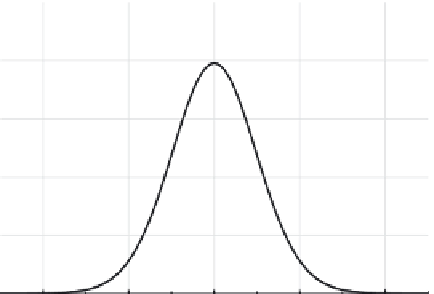Environmental Engineering Reference
In-Depth Information
The cumulative chi-square distribution is given in
Appendix C.3.
0.5
0.4
EXAMPLE 10.4
0.3
A random variable is calculated as the sum of the
squares of 10 normally distributed variables with a
mean of zero and a standard deviation of 1. What is the
probability that the sum is greater than 20? What is the
expected value of the sum?
n
= 30
0.2
0.1
0.0
Solution
-4
-2
0
2
4
t
The random variable cited here is a
χ
2
variate with 10
degrees of freedom. The cumulative distribution of the
χ
2
variate is given in Appendix C.3 as a function of the
number of degrees of freedom,
ν
, and the exceedance
probability,
α
. In this case, for
ν
= 10, and
χ
2
= 20,
Appendix C.3 gives (by interpolation)
Figure 10.5.
Student's
t
probability distribution.
The cumulative
t
distribution is given in Appendix
C.2. The
t
distribution has a similar shape to the normal
distribution; however, there is more area under the tails
of the
t
distribution compared with the normal distribu-
tion. It is sometimes stated that the
t
distribution has a
“heavier tail” than the normal distribution. As the
number of degrees of freedom,
ν
, gets large, the
t
distri-
bution approaches the standard normal distribution.
The standard normal distribution can be used instead of
the
t
distribution for
ν
> 30.
α= 0 031
.
Therefore, the probability that the sum of the squares
of 10 n(0,1) variables exceeds 20 is 0.031 or 3.1%.
The expected value of the sum is, by definition, equal
to the mean,
µ
χ
2
, which is given by Equation (10.43) as
µ
= =
ν
10
χ
2
EXAMPLE 10.5
10.4.2 Student's
t
Distribution
A variable,
Z
, is calculated using the formula
If
X
and
Y
are independent random variables where
X
is normally distributed with mean 0 and variance 1, and
Y
is chi-square distributed with
ν
degrees of freedom,
then the random variable defined by the relation
X
Y
Z
=
/ ν
where
X
is a
N
(0,1) variate and
Y
is a chi-square variate
with
ν
degrees of freedom. If
ν
= 20, estimate the prob-
ability that
Z
is greater than 2.0. What is the expected
value of
Z
?
X
Y
T
=
/ ν
(10.44)
has a probability distribution given by
Solution
2
−
(
ν
+
1 2
)/
Γ
[(
ν
+
1
) /
2 1
](
/ )
( / )
+
t
ν
f t
( )
=
,
−∞ < < ∞
t
,
ν
> 0
From the given information,
Z
has a Student's
t
distribu-
tion. The cumulative probability distribution is tabu-
lated in Appendix C.2 as a function of the number of
degrees of freedom,
ν
, and the exceedance probability,
α
. For
ν
= 20, and
Z
= 2.0, Appendix C.2 gives (by
interpolation)
νπ ν
Γ
2
(10.45)
The distribution function
f
(
t
) is called the
Student's t
distribution
with
ν
degrees of freedom. The shape of the
Student's
t
distribution is illustrated in Figure 10.5. The
mean and variance of the distribution are
α= 0 031
.
ν
ν
Therefore, the probability that
Z
exceeds 2.0 is 0.031
or 3.1%.
(10.46)
µ
=
0
,
σ
2
=
for
ν
>
2
T
T
−
2










Search WWH ::

Custom Search